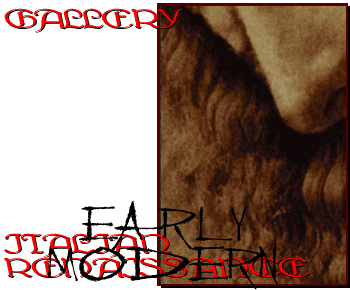


|
Giuseppe Arcimboldo, Spring Giuseppe Arcimboldo (d. 1593) was a Milanese mannerist painter who delighted in visual tricks, such as this one. The painting is actually a still-life painting of flowers; their combination, however, produces the illusion of a profile portrait of a man. Arcimboldo represents perhaps the extreme of Italian mannerism in which the predominant subject of his trick paintings is the painting itself and its illusion. Copyright, 1995, Corel Corporation. See the Corel License Agreement under which these pictures are published. This image is to be used only for educational activities in connection with the classes connected to this site. To include a browser-sized version of this picture in your multimedia projects, make an image link to http://www.wsu.edu:8080/~dee/GRAPHICS/GALLERY/REN/ARC1S.JPG |

|
Agnolo Bronzino, Portrait of a Young Man Agnolo Bronzino represents anoher pole of mannerist painting in Florence. While the mannerists stressed human striving and emotion, Bronzino developed a new and colder style. He also reintroduced the older Renaissance concept of harmony and symmetry in his paintings; whereas early mannerst paintings strove to unbalance the figures and geometry in a painting, Bronzino sought to foreground this balance and symmetry as one of the primary objects of the painting. While his "Venus Disarming Cupid" is his most famous painting for its rigid symmetry and its chilling eroticism, the "Portrait of a Young Man" is equally famous as a portrait. The figure itself is emotionless to the point of not being human, but it occupies a highly ordered and balanced space of which it is a part. Copyright, 1995, Corel Corporation. See the Corel License Agreement under which these pictures are published. This image is to be used only for educational activities in connection with the classes connected to this site. To include a browser-sized version of this picture in your multimedia projects, make an image link to http://www.wsu.edu:8080/~dee/GRAPHICS/GALLERY/REN/BRONZ1S.JPG |

|
Paolo Veronese, The Finding of Moses Paolo Veronese (1528-1588), along with Tintoretto, was one of the great Venetian painters of the late Renaissance. His paintings use figures in classical poses, but he rejects conceptual painting. The figures in his paintings are always human beings, never ideas or representations of ideas. In his depiction of the finding of Moses, the figures are normal Italians such as one would find in any wealthy court. The focus is less on the infant Moses than it is on modern Italian life, culture, and dress. In this and other biblical paintings that he executed, the visual space is filled with extra figures, such as dwarfs and pages. Because of this, Veronese was called before the Inquisition for showing disrespect to the Bible. In his defense, he claimed that all painters have the duty to fill space with "diversions." We've come quite far from the early Renaissance and its stress on visual meaning when we arrive at Veronese's "diversions." Copyright, 1995, Corel Corporation. See the Corel License Agreement under which these pictures are published. This image is to be used only for educational activities in connection with the classes connected to this site. To include a browser-sized version of this picture in your multimedia projects, make an image link to http://www.wsu.edu:8080/~dee/GRAPHICS/GALLERY/REN/VERON1S.JPG |
